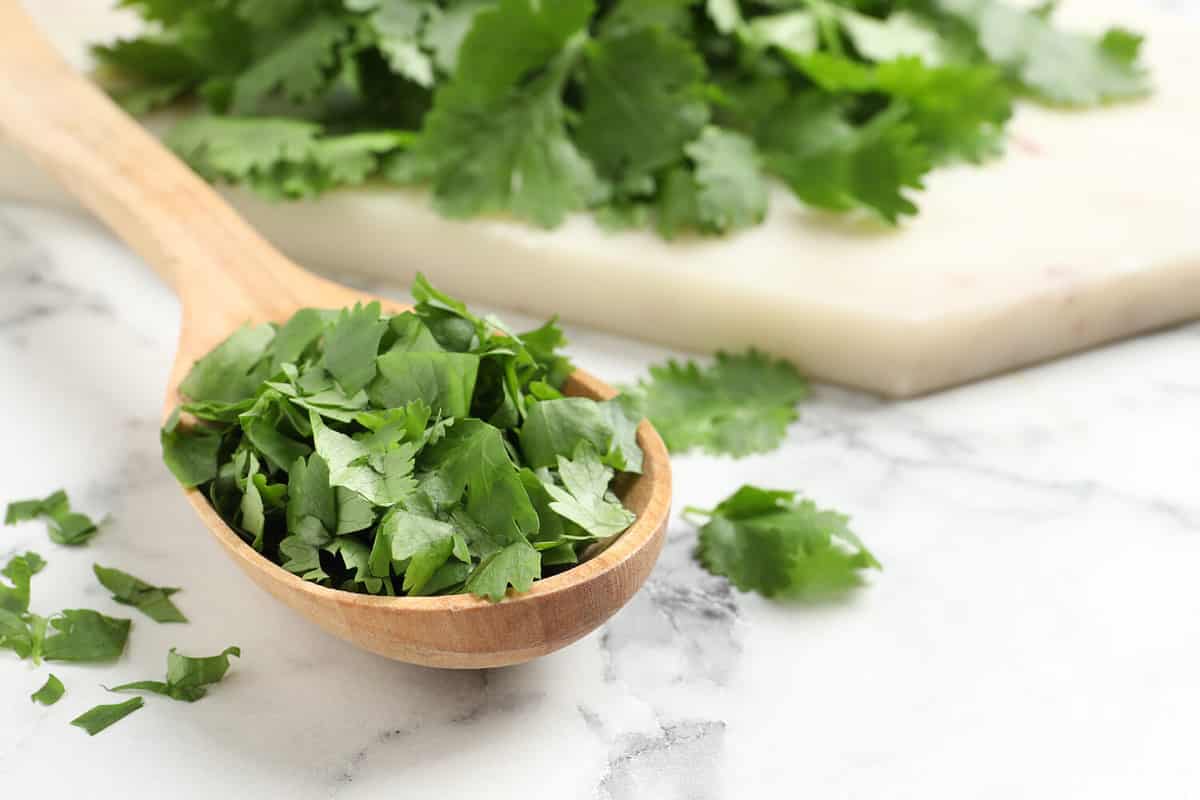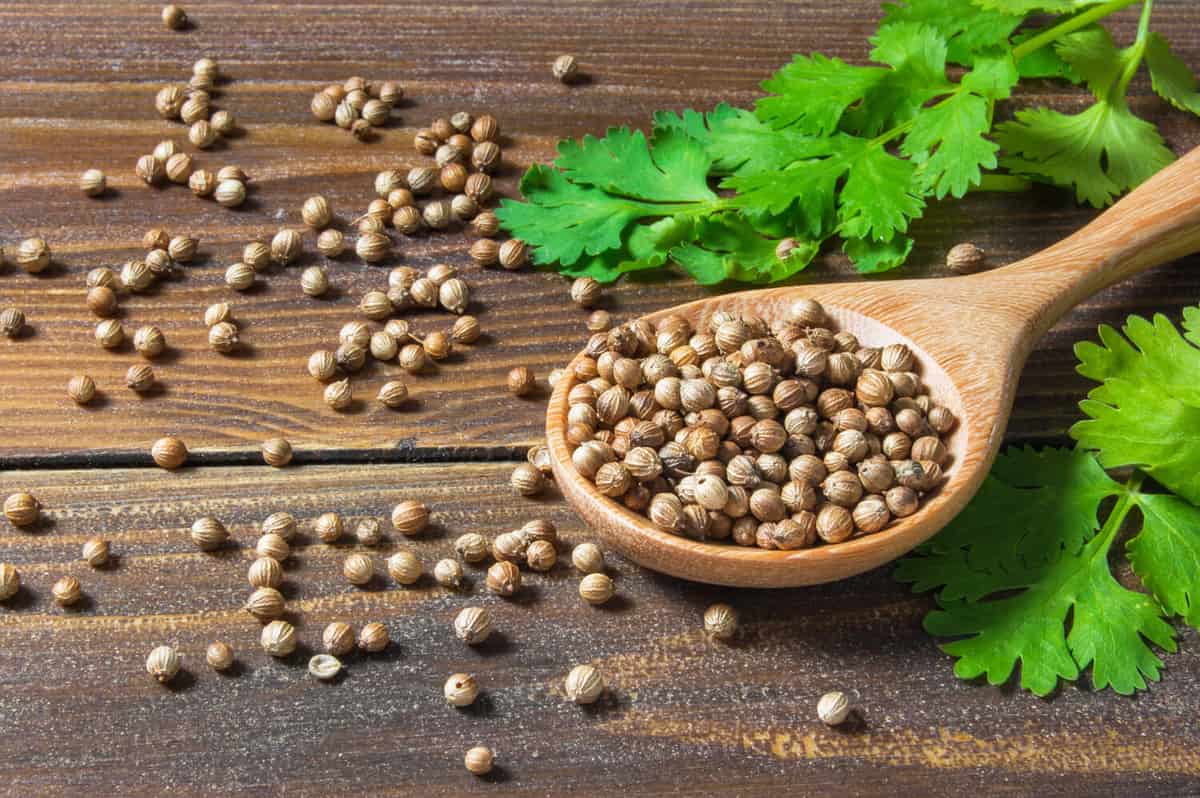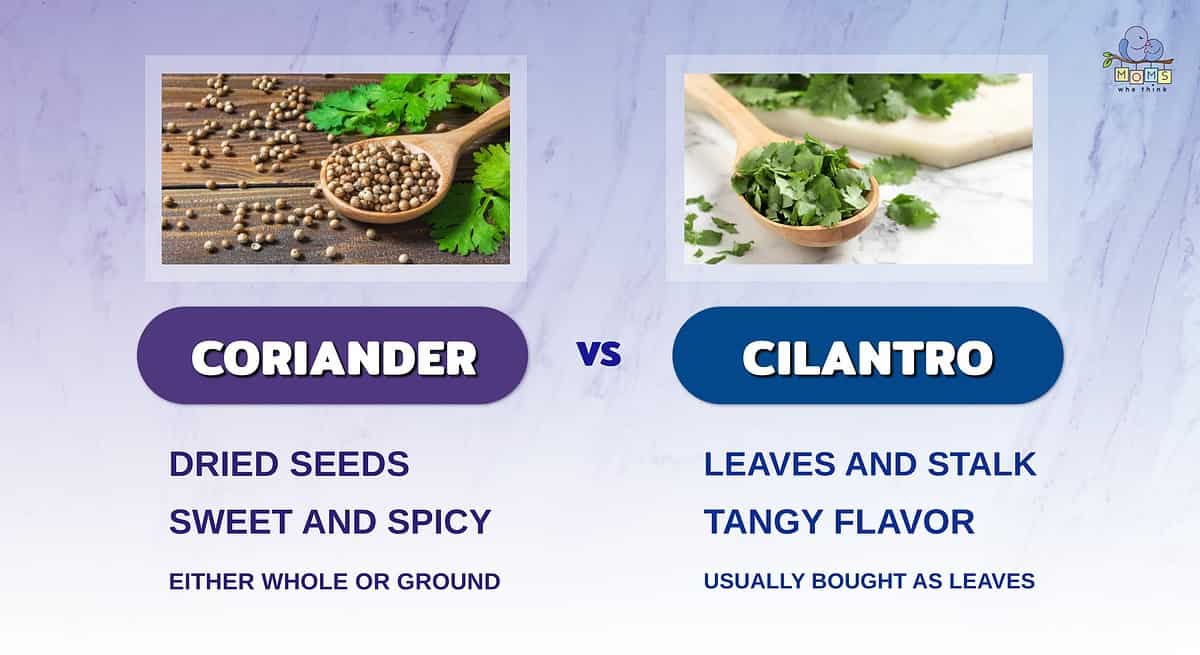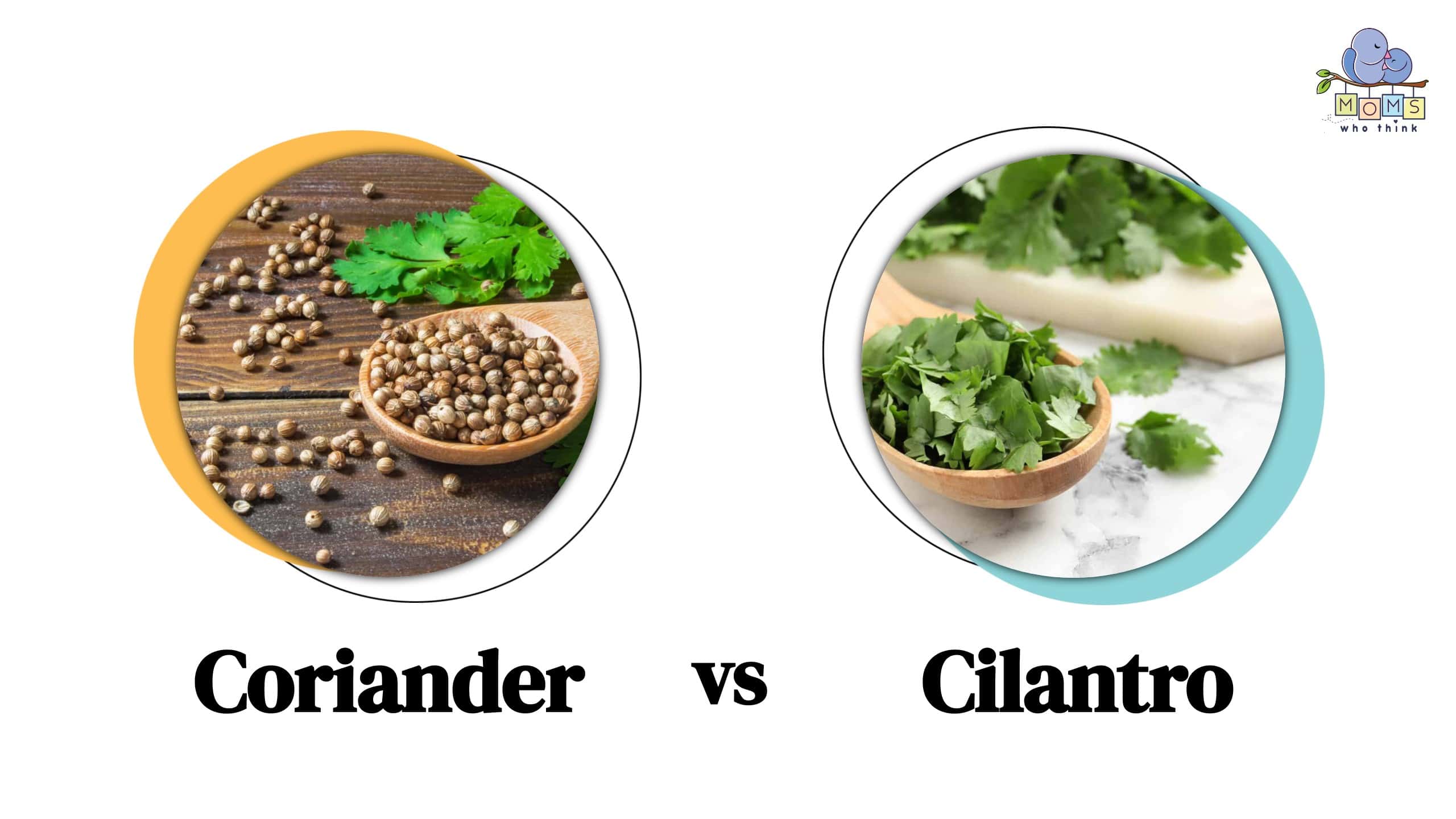Across the world, there are many varying opinions on cilantro. Or rather, some people love it, and some people think it tastes like soap. For those who are fans of cilantro, it’s great to put on top of tacos or in soups and salads. Whether you like this herb or not, you’ve likely heard of it before, but do you know the relation between coriander and cilantro? Some people know about the differences between coriander vs cilantro while others may think they’re completely different herbs or spices.
Cilantro and coriander are actually two different parts of the Coriandrum sativum plant. In North America, cilantro refers to the leaves and stalk while coriander refers to the dried seeds that come from the plant. The main difference in their flavor is coriander is sweet and spicy while cilantro has a tangy flavor.
Even though they come from the same plant, coriander and cilantro have many differences, including their uses in the kitchen. Keep reading to find out the main differences between coriander and cilantro as well as their nutritional values.

Cilantro refers to the leaves and stalk of the Coriandrum sativum plant.
©New Africa/Shutterstock.com
Coriander vs. Cilantro: What is the Difference?
Coriander and cilantro are both popular ingredients in a variety of dishes. No matter what type of meal you’re cooking, there are numerous ways to use both cilantro and coriander, but have you ever wondered about the difference between them? Although they do come from the same plant, there are quite a few differences between them.
What coriander and cilantro have in common is they both come from the same plant. Cilantro is the name of the stems and leaves of the plant. On the other hand, the seeds produced when the plant flowers are known as coriander.
In Spanish, cilantro is the word for coriander, which can make the difference between the two confusing. In North America, cilantro refers specifically to the leaves and stalk of the Coriandrum sativum plant. While cilantro is sold as an herb, you’ll find coriander in the spice aisle as either whole seeds or ground coriander.
Along with the cilantro and coriander coming from different parts of the plant, they also have different uses in the kitchen as well as different flavors. Cilantro has a tangy flavor while coriander seeds often have a sweet and spicy profile. You’ll often find coriander as an ingredient in Indian dishes while cilantro is more popular in Asian and South American dishes.
Key Differences Between Coriander and Cilantro
While it’s easy to confuse coriander seeds with cilantro, there are some differences between them. Here are the key differences between coriander vs cilantro:
- They come from different parts of the plant
Even though cilantro and coriander both come from the Coriandrum sativum plant, cilantro is the leaves and stalk while coriander is the seeds from the plant. - They have different flavors
Despite the fact that they come from the same plant, cilantro and coriander have widely different flavors. While coriander is described as sweet and slightly spicy, cilantro has a citrus-like and tangy flavor. - They come in different forms
Since cilantro and coriander come from different parts of the plant, their appearances are pretty different. When purchased as a fresh herb, cilantro comes in the form of leaves. You can find coriander in the spice aisle as either whole seeds or a ground spice.
What is Coriander?
In North America, coriander refers to the seeds that come from the Coriandrum sativum plant. Sometimes, the name coriander is used to describe the whole plant including the cilantro leaves and coriander seeds. However, if you see coriander in the spice aisle, it’s a different part of the plant than cilantro.
Coriander seeds are generally beige in color and have both a sweet and spicy flavor. You can purchase these seeds whole or ground.
While there are a variety of ways you can use coriander or coriander seeds, they’re most often included as a seasoning in numerous dishes. These seeds are particularly popular in many Indian cuisines, but there’s no limit to the ways you can use coriander to spice up any meal.
How Do You Use Coriander?
You can purchase coriander in most grocery stores as either whole seeds or as ground coriander, which can be used as a seasoning in numerous meals. While it might seem inconvenient to grind coriander yourself, you’re going to have a much fresher flavor if you purchase the seeds whole.
Once coriander is ground, it starts to lose its flavor. Considering the flavor profile of coriander seeds, they’re a popular ingredient in many Indian-inspired dishes like curries. It’s also common to use coriander as a seasoning for pickled vegetables. Additionally, Dhana dal is a popular snack in Indian cuisine made of roasted and crushed coriander seeds.
What is Cilantro?
Cilantro generally refers to the leaves or stalk of the Coriandrum sativum plant. In this case, cilantro is a leafy green herb perfect for a wide range of recipes. It has a citrus-like flavor and is popular in Asian and Mexican cuisines. You’ll find cilantro as an ingredient in many taco recipes and it’s also a popular herb to sprinkle on top of fresh guacamole.
While cilantro and coriander aren’t the same, they are different parts of the same plant. Despite this fact, they have different scents and flavors. The flavor of cilantro is often described as fresh, citrus-like, and tangy. Cilantro is also incredibly aromatic and is often used as a garnish in recipes.
How Do You Use Cilantro?
Cilantro, like coriander, has many different uses. Since cilantro comes as a fresh herb, it’s often used as a garnish in salads or sauces. It’s also a popular ingredient in Asian, South American, and Mexican cuisine.
In the United States, you’ll often see cilantro used as a garnish for added flavor in dishes like tacos, salads, and guacamole. However, there are many creative ways for you to use cilantro and you’ll often see it in salsas, chutneys, and soups as well.

Since they come from the same plant, many of the health benefits of cilantro and coriander are the same.
©boommaval/Shutterstock.com
Benefits of Using Cilantro and Coriander
Like many fresh herbs and spices, cilantro and coriander come with many potential health benefits. Since they come from the same plant, they have many benefits in common. Here are some of the health benefits that cilantro and coriander can lead to:
Reduce Inflammation
Cilantro and coriander are chock-full of antioxidants. These antioxidants are helpful for reducing inflammation in the body. One study even showed that cilantro extract could reduce skin aging in animals due to the suppression of free radicals in the body.
Additionally, one study of coriander seed extract showed that it reduced inflammation and prevented the growth of cancer cells in the body.
Reduce Risk Factors for Heart Disease
Heart disease is a serious issue, but both cilantro and coriander have been shown to reduce some of the risk factors. Additionally, it can reduce the formation of blood clots, which ultimately can reduce the risk of heart disease. This is also true of coriander which has been studied as a way to reduce blood pressure and as a treatment for high cholesterol.
Fight Infections
Both cilantro and coriander seeds are known to have antibacterial properties. This can lead to them fighting off certain infections by helping to kill the bacteria in certain foods. However, more studies need to be done to see how this can apply to infections in humans.
Can You Substitute Cilantro for Coriander?
While it would be safe to do so, substituting coriander for cilantro won’t necessarily work because of the different flavors. On the one hand, cilantro has a tangy flavor while coriander can be sweet or even have a spicy profile.
Even though in the United States, coriander means the seeds of the Coriandrum sativum plant and cilantro refers to the leaves or stalk, this isn’t the case in other countries. If you do use a recipe that calls for coriander or cilantro, be sure you’re using the right one or the flavor will be vastly different.
A Quick Comparison of Coriander vs. Cilantro

Coriander refers to the seeds of the Coriandrum sativum plant, while cilantro refers to the leaves and stalk of this plant. The taste of coriander has been described as sweet and slightly spicy, while cilantro has a citrusy, tangy flavor. It's important to keep these differences in mind when trying to decide which to use in a recipe. Coriander can be bought ground or whole, while cilantro is usually sold as whole leaves. Both coriander and cilantro have great uses in the kitchen, and deserve a spot in your pantry.
Cilantro Recipes
Print
Cilantro and Lime Beef Enchiladas
Ingredients
1–2 T. extra virgin olive oil
1 pound lean ground beef (You can also use rotisserie chicken)
1 medium onion, minced
3 cloves garlic, pressed
1 green pepper, finely chopped
1 T chili powder
1/2 tsp cumin
1/2 tsp coriander
1/2 tsp oregano
1/2 tsp freshly ground black pepper
3/4 tsp kosher salt
1 cup sour cream
Juice of 1 Lime
1 c Mexican blend cheese
2 T chopped fresh parsley or cilantro
1 (8-oz) can tomato sauce
10–12 small flour or corn tortillas
1–2 (10-oz) cans of red enchilada sauce
2 cups shredded cheddar or Colby Jack cheese
Instructions
1. Set your oven to 350 degrees F.
2. In a large skillet over medium heat, add your beef, garlic, onion, green pepper and spices. Cook until beef is cooked through and onion is translucent.
3. Pour into a bowl and add your sour cream, Mexican blend cheese, parsley or cilantro, lime juice, and tomato sauce. Add mixture to tortillas, roll them up and place them in the pan. Pour enchilada sauce over the top and add your remaining cheese. Bake uncovered for about 20 minutes (until cheese is melted), and top with cilantro, sour cream, salsa, tomatoes, chopped lettuce, olives or any other desired toppings. Cook up some Mexican rice to serve with the beef enchiladas.
- Spaghetti Squash with Edamame-Cilantro Pesto
- Chinese Pork with Snow Peas
- Steak Tacos with Cucumber-Avocado Salsa
- Pineapple, Mango, and Chicken Kabobs
Coriander Recipes
- BBQ Pork Pot Pie
- Pork and Poblano Pozole
- Hot and Spicy Goulash
- Chicken and Veggie Enchiladas
- Slow-Cooked Caribbean Pot Roast


